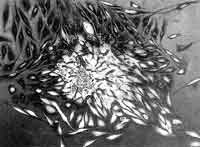And now, green genes
 more than half of all tumour cells contain tiny extra chromosomes that encourage the cancer to grow. Now scientists may finally be able to find a way to obviate cells of the excess dna , using a technique that lets them watch these chromosomes at work in living cells.
more than half of all tumour cells contain tiny extra chromosomes that encourage the cancer to grow. Now scientists may finally be able to find a way to obviate cells of the excess dna , using a technique that lets them watch these chromosomes at work in living cells.
Called double minute chromosomes, these renegade dna contains genes that have been duplicated and subsequently broken away from the chromosome where they are usually found. Double minute chromosomes have never been seen in healthy cells. "They are absolutely specific to cancer,' says Geoffrey Wahl, a cancer researcher at the Salk Institute in La Jolla, California, usa . Without double minute chromosomes, he thinks, many tumours would stop growing.
These renegades have been difficult to study, says Wahl, precisely because they are so small to see. Even the largest of them are roughly a thousandth the size of a normal human chromosome and is visible only through cell staining. Unfortunately, standard dna stains are toxic to cells because they damage the dna .
So Wahl and his colleagues took advantage of a set of proteins called histones found in the all eukaryotic cells. Histones wrap themselves in dna, condensing the immensely long strands found in a cell's nucleus. The team fused a human histone gene to the gene for the protein that gives certain jellyfish their greenish glow. This made all the chromosomes of cell cultures, as well as the double minutes, glow bright green ( Current Biology , Vol 8). "It worked perfectly,' says Wahl.
Using the green histones , Wahl's team confirmed earlier reports that double minutes hitch a ride to daughter cells during cell division. Ordinary chromosomes are dragged into each new cell by molecular handles called cantomeres, which the double minutes lack.
During cell division, the researchers saw double minutes gather together and latch onto the normal chromosomes. "They look like green grapes in a cluster,' says Wahl. By hitch-hiking like this, the renegade double minutes get passed on to a cancer cell's progeny.
This technique could soon adapted to screening for drugs that eliminate the double minutes. This would involve applying a battery of drugs to cancer cells into which the green histone gene had been inserted, and then monitoring the growth medium. If cells expel their double minutes, the growth medium will acquire a fluorescent hue.
"This is going to leapfrog us ahead,' claims John McGill, a cancer researcher and an expert on the double minute chromosomes at the University of Texas in San Antonio, usa . "It will help us get rid of these characters from tumour cells.'
